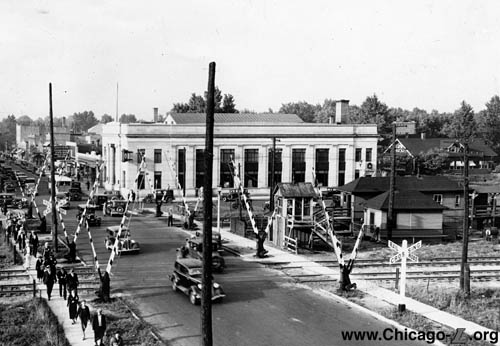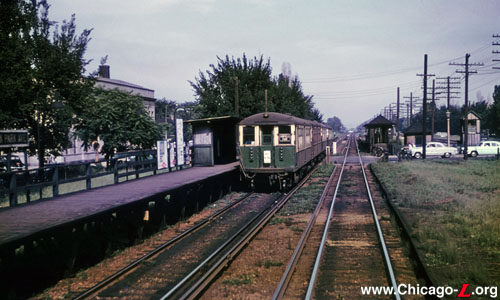|

A gauntlet of tracks and crossing gates confronts the public looking north at Oak Park station on September 6, 1935. The tracks in the foreground belong to the Baltimore and Ohio Chicago Terminal Railroad, a terminal railroad formerly giving various other companies access to Grand Central Station. The "L"'s Garfield Park branch tracks are beyond that, with the Oak Park station house for inbound rapid transit passengers visible on the right. For a larger view, click here. (Photo from the Graham Garfield Collection)
|
Oak Park
(800W/900S)
Oak Park Avenue and
Harrison Street, Village of Oak Park
Service
Notes:

|
Garfield
Line
|
Quick Facts:
Address: TDB
Established: March 11, 1905
Original Line: Metropolitan West Side Elevated, Garfield
Park branch
Previous Names: none
|
Skip-Stop
Type:
|

|
Station
|
Rebuilt: n/a
Status: Demolished
History:
The Aurora
Elgin & Chicago interurban began service from Aurora and
Wheaton to a connection with the "L" at 52nd
Avenue (Laramie) on August 25, 1902. Included on the AE&C's
main line was a station at Oak Park Avenue. The AE&C's (later
reorganized as the Chicago Aurora & Elgin) service to stations on
this segment of their main line was short-lived, as the Metropolitan
"L" assumed local service between 52nd
Avenue and Desplaines Avenue on
March 11, 1905, relieving the AE&C of this unwanted chore. The
extension of Garfield
Park service to Desplaines and the
Met's servicing of the local stations between was part of the
reciprocal trackage agreement that allowed the AE&C to extend to
downtown Chicago and the Fifth Avenue
Terminal over the Metropolitan Elevated.
The Chicago
Aurora & Elgin interurban, which used the Garfield
Park branch to reach downtown Chicago, continued to serve Oak
Park station until September 20, 1953, discharging passengers
eastbound and picking up westbound.
The Oak Park station was a simple facility located at ground
level, as the Garfield
Park line ran at-grade west of Cicero
station. One interesting aspect of Oak Park station's arrangement was
that the platforms were on different sides of Oak Park Avenue. There
were actually three different platforms: the "L" had two high-level
wooden platforms, with the inbound platform was on the east side of
the street and the outbound platform was on the west side of the
street. The CA&E discharged passengers eastbound at a low-level
cinder platform on the west side of Oak Park Avenue, separate from the
"L". Both companies used the same platform westbound where there was
less worry about CA&E riders transferring for free to the
"L".
Oak Park
station still had a station house on the inbound "L" platform on the east side of Oak Park Avenue. The design was
typical of other small wood frame ground-level Met station houses.
The headhouse was positioned between the street and the boarding
platform, requiring passage through the station house before reaching
the platform. The exterior used clapboard siding and a peaked roof
with eaves that extended out about a foot. The front features one set
of double doors, while the sides are broken up by four double-hung
sash windows. The rear opened out onto the inbound platform. The
interior was most likely floor-to-ceiling tongue-in-groove paneling,
wood floors and paneled ceilings with a small ticket booth near the
entrance, benches along the walls, a boiler stove for heat and
incandescent lights for illumination.
During the 1950s, the City of Chicago and Cook County undertook
construction of the Congress Superhighway [Eisenhower
Expressway] along the general alignment of the Garfield
Park "L" line. Part of the project also included the new new
Congress "L" Line to
replace the Garfield
Park. The Congress Expressway opened in stages between 1955 and
1960; on June 22, 1958, the first section of the new Congress
Line opened between Halsted and
Laramie, replacing the Garfield
Park elevated.
Work on the Congress Expressway and "L" line west of Laramie
Avenue resulted in some complicated staging and several temporary
facilities along the at-grade portion of the Garfield
Line. On September 6, 1957, westbound Garfield
Line trains shifted to a set of temporary tracks from Austin to
west of Oak Park, north than the previous alignment. Concurrent with
the move to the temporary alignment west of Austin, a temporary
island platform was opened on east side of Oak Park Avenue for
westbound trains and the old westbound side platform on the west side
of Oak Park Avenue was closed. Eastbound trains followed onto the
temporary alignment and began using the temporary island platform on
September 17, closing the old eastbound side platform and station house on the east
side of Oak Park Avenue.
Just under three years later, the permanent right-of-way was
ready, although the permanent replacement Congress
Line station was not. On March 19, 1960, the permanent eastbound
Congress Line track
was placed in service between Waller and Desplaines in open cut
alongside site of future expressway. The new permanent Oak
Park station's island platform, with temporary fare controls, was
placed in service on the west side of Oak Park Avenue. The next day,
on March 20, the permanent westbound track was also placed in
service, closing the previous temporary platform.
|

A westbound Garfield Park train -- a mixed consist of Baldie and Plushie 4000-series cars -- pulls into Oak Park station circa 1954. The platforms at Oak Park are staggered; the station house and inbound platform can be seen across the street in the background. The white sign on the train's front chains reads, "MEETS 4:36 CA&E". After the interurban cut back its trains from the Loop to Forest Park in 1953, many commuters rode the "L" to connect to interurban trains to the western suburbs. The CTA assisted customers by having trains carry signs that noted what CA&E trains they connected with. For a larger view, click here. (Photo by B.L. Stone, courtesy of the Krambles-Peterson Archive)
|




